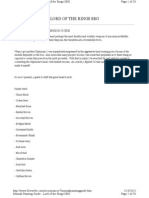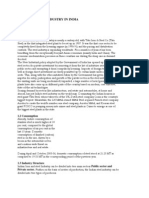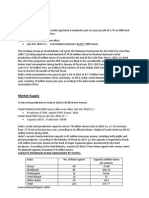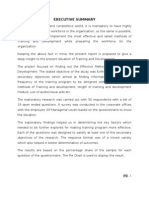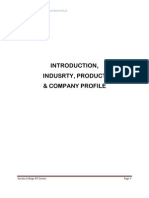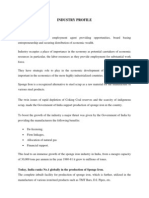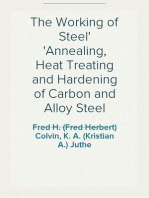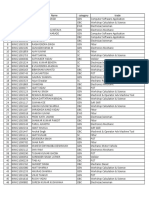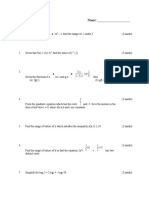Why Steel Consumption in India Should Rise?
Why Steel Consumption in India Should Rise?
Uploaded by
fahrgeruste3961Copyright:
Available Formats
Why Steel Consumption in India Should Rise?
Why Steel Consumption in India Should Rise?
Uploaded by
fahrgeruste3961Original Title
Copyright
Available Formats
Share this document
Did you find this document useful?
Is this content inappropriate?
Copyright:
Available Formats
Why Steel Consumption in India Should Rise?
Why Steel Consumption in India Should Rise?
Uploaded by
fahrgeruste3961Copyright:
Available Formats
Lecture 40: Status of Steelmaking in India
Steel belongs to iron-carbon system and this system has the following unique features: Fe-carbon system possesses some solubility for several elements of the periodic table whic results into production of diversified range of materials for application to all industries including aero- and auto industries Steel is recyclable and hence is a green material. Also the main element in steel is iron and iron is the fourth abundant element in the earth crust and corresponds to 5% of the weight of the earth crust.
Steel is a material which can be made available for most of the engineering applications. Steel is one of the infrastructural materials that are needed for the economic growth and hence for the industrial growth of any nation.
Why Steel consumption in India should rise? India is a developing nation. It requires industrial growth for the prosperity. The per capita consumption of steel in India is 40 kg as compared with an average 150 kg across the globe and 250 kg in China. Low per capita consumption of steel indicates that no meaningful infrastructural development has occurred in the country as a whole. India needs large consumption of steel for the growth of the following infrastructures: Modernization of air ports Expansion of railway tracks Auto industry Road projects Real estates Safety and other development programmes of Indian railways
Growth in the above sectors will automatically raise the per capita steel consumption. It is estimated that per capita steel consumption will rise to 110 kg by the year 2020-21 and 300 kg by the year 2030-31. These projections may look to be optimistic, but one thing is certain and that is steel requirement will increase in India in the near future. To sustain the steel requirement, Indian steel industry has to grow fast.
Indian Steel Industry Indian steel industry is organised in three sectors, namely integrated plant, mini steel plant based on EAF, and induction furnace. Integrated steel plant sector is the biggest producer of steel. The steel production is based entirely on hot metal. The route consists of Blast furnace-converter-secondary steelmaking-continuous
casting-and rolling. Integrated steel plants are both in public and private sector. In the public sector Steel Authority of India Ltd. (SAIL) and Rashtriya Ispat Nigam Ltd. (RINL) are the main producers of steel. SAIL has plants located at Bhilai, Rourkela, Durgapur, Bokaro, Burnpur. Salem and Bhadravati. RINL has plant at Vishakhapattnem. The total capacity of steel production is 18-19 million tons per annum. In the private sector Essar, ISPAT, Jindal and TISCO are the main producers with the total capacity of 12 million tons per annum. Mini steel plant sector mainly produces steel through electric arc furnace using scrap, pig iron and sponge iron. Several mini steel plants are dispersed in the country to produce mild steel and alloy steel both for long and flat products. This sector depends entirely on availability of scrap and sponge iron. In many of these units, mini blast furnace hot metal is also used in the charge. Many producers have installed high frequency induction furnaces (IF) to produce mild steel and alloy and special steels. Induction furnace based steel producers have modernised by using refining equipments as well as continuous casting units. Refining by ladle arc furnace is also in use. The EAF holders have also installed induction melting furnaces. Induction furnaces consume less power, and there is no expenditure on electrode. Limitation is only that induction furnace based plants are not suitable for bulk steel production. The combined EAF + IF sector had contributed 50% in the total steel production in the year 2005-06
Steel production in India India produced 55.4 million tonnes of finished carbon steel in 2006-07 which has marginally increased to 59.02 million tonnes in 2008-09 as per the report given by the Joint Plant Committee. Crude steel production was registered at 51.5 million tonnes during April-December 2010 in the country as per the report of the joint Plant Committee. The production is expected to be nearly 110 million tonnes by 2012-13. Steel production in India has increased by a compounded annual growth rate (CAGR) of 8.4% during the period 2005-06 to 2009-10. The crude steel performance accounted for 31% of the total crude steel production in the country during 2009-10, contributed mainly by the strong trends in the growth of the electric route of steelmaking, particularly the induction furnace route. Going forward, growth in India is projected to be higher than the world average, as per capita consumption of steel in India, at around 40 kg, is well below the world average (150kg) and that of developed countries (400 kg).
Raw materials situation in India To meet the future demand of steel, one has to ensure the supply of basic raw materials to the steel industry. Metallurgical grade coking coal, scrap, iron ore and sponge iron are, among others the important raw materials for steel production through different routes. Metallurgical grade coking coal Blast furnace-BOF route will continue to play a significant role to meet the increased demand of steel. This route is dependent entirely on the availability of hot metal through blast furnace. Blast
furnace cannot work without coke and coke is produced by carbonization of metallurgical grade coking coal. Shortage of metallurgical grade coking coal reserves within the country is of serious concern. For the long time India is dependent on the imported high grade, low ash coking coal from Australia amounting to 30 to50% of its total requirement. In the future import of coking coal may become expensive. Thus, integrated steel plants producers must search ways and means to operate the blast furnace with the bare minimum coke consumption (the bare minimum coke is that which is just required to maintain the permeability of the bed in the blast furnace). Other technologies like pulverised coal and tar injection in the blast furnace must also be explored. Additionally, smelting reduction processes like COREX, ROMELT must also be developed to supplement the hot metal.
Iron ore The situation with respect to iron ore is good as long as appropriate export policies are put in place. With the growth of steel production to 110 million tons per annum by 2019-20, iron ore requirement would be around 200 million tons. Iron ore reserves may not create much problem to sustain the steel production at least for the next two or three decades.
Scrap Scrap is an important raw material for the growth of EAF and IF. The shortage of scrap necessitates the search for alternative raw materials. In this connection sponge iron (also known as directly reduced iron or DRI) has proved to be a promising alternative to scrap. In fact there are electric furnaces which are operating with large percent of sponge iron in the feed. Sponge iron is produced by reducing iron ore either by using coal or natural gas. Under Indian conditions coal based sponge iron processes are more attractive as compared with gas based ones. Several coal based sponge iron plants are operating in the states of Chattisgarh, Orrisa, West Bengal and Jharkhand doe to availability of high grade iron ore in these states. DRI plants are installing various capacity induction furnaces to produce mild steels for long product applications. Secondary producers of steel are located in all parts of India to meet the local specialised demand of steel. Their share in Indias total steel production may reach up to 50%
Outlook The outlook for Indian steel industry is very bright. Indias lower wages and favourable energy prices will continue to promise steel production at lower cost as compared with western part of the world. In the future, Indian steel industry has to grow either by adding capacity in the exisating steel olanta or by installing new integrated steel plants. Following information is reproduced from the internet search: Category: Steel companies in India-Wilkepedia: Bhushan Steel limited will be setting up an intergrated steel plant in west Bengal with facilities including slab plant, coke ovens and captive power plant. They have also proposed to set up a 6
million tonne per annum integrated steel plant as an expansion of its existing plant being set up at Meramandali (Distt dhenkanal) in Orissa. Bokaro steel plant is undergoing a mass modernisation drive after which its output capacity is expected to cross 10 million tonnes Jindal Vijayanagar steel (JVSL) will be adding 3.2 million tons per annum to achieve 11 million tonnes per annum by 2011. POSCO signed a memorandum of understanding with the government of Orrisa to set up a 12 million tonnes per annum green field steel plant near paradip, Jagatsinghpur district, Orrisa. Tata steel has set an ambitious target to achieve a capacity of 100 million tonnes by 2015 through a series of Greenfield projects in India and outside which includes 6 million tonnes plant in Orissa, 12 million tonnes in Jharkhand, 5 million tonnes in Chattisgarh, 5 million tonnes capacity expansion at Jamshedpur and in few other countries like Iran, Vietnam and Bangladash Vizag steel plant is the onl;y Indian shore based steel plant and is poised to become up to 20 million tonnes in a single campus. Recently it has gone expansion from 3.1 million tonnes to 6.3 million tonnes. Another public sector company, NMDC is to set up a 3 million ton per annum integrated plant at Nagarnar, Chhattisgarh. The plant is likely to be commissioned in 2014. In addition to the above the steel plants at Bhilai, Rourkela, Durgapur and others are in the process of modernisation and capacity addition. India is poised to be worlds 2nd largest producer of steel before 2016. Indians steel production will be nearly 124 million tonnes by 2012 and that the country could achieve an annual capacity of around 275 million tonnes by 2019-20
Refernce: Category: Steel companies in India-Wilkepedia, Internet Chandra Bhushan: Challenge of new balance Internet Joint Plant Committee report as available on the internet
You might also like
- Painting The MumakDocument50 pagesPainting The MumakBarghusNo ratings yet
- Wire DrawingDocument18 pagesWire DrawingstaniNo ratings yet
- A Study of Electronic Data Storage Steel Factory in Mumbai11Document71 pagesA Study of Electronic Data Storage Steel Factory in Mumbai11Thirupal Nk100% (3)
- Assignment of MarketingDocument9 pagesAssignment of MarketingHemant DubeyNo ratings yet
- Steel IndustryDocument21 pagesSteel IndustryBhupen YadavNo ratings yet
- Industry Profile: Steel Industry Is Becoming More and More Competitive With Every Passing Day. During TheDocument19 pagesIndustry Profile: Steel Industry Is Becoming More and More Competitive With Every Passing Day. During Thevinay8464No ratings yet
- Iron and Steel Industry in IndiaDocument16 pagesIron and Steel Industry in IndiaAnonymous gQyrTUHX38100% (1)
- Iron and Steel Industry in IndiaDocument10 pagesIron and Steel Industry in IndiaJordan SarasanNo ratings yet
- Iron and Steel IndustryDocument17 pagesIron and Steel IndustryEMJAY100% (1)
- Steel Industry Concept PaperDocument4 pagesSteel Industry Concept PaperAjay ChauhanNo ratings yet
- Steel Has An Oligopoly Market IDocument6 pagesSteel Has An Oligopoly Market Iarchana783No ratings yet
- Essar Steel Finance ReportDocument53 pagesEssar Steel Finance ReportJigar PatelNo ratings yet
- Steel Industry: BY-Mithil Joshi Khyati PatelDocument27 pagesSteel Industry: BY-Mithil Joshi Khyati PatelMithil JoshiNo ratings yet
- Capital BudgetingDocument105 pagesCapital BudgetingAjay Kumar Mahto100% (1)
- Vtu HR Project On Employee Job Satisfaction.Document70 pagesVtu HR Project On Employee Job Satisfaction.Naveen Babu DNo ratings yet
- Internship Report BadriDocument47 pagesInternship Report BadrisachingowdacvNo ratings yet
- Marketing Strategies and 4 P's of Bokaro SteelDocument73 pagesMarketing Strategies and 4 P's of Bokaro SteelAmit Kumar100% (7)
- Internship Report BadriDocument46 pagesInternship Report BadrisachingowdacvNo ratings yet
- Problem and Prospect of LSIDocument14 pagesProblem and Prospect of LSIakky.vns2004No ratings yet
- 347 - Make in India in Blast FurnaceDocument9 pages347 - Make in India in Blast Furnacebaccha1556677788No ratings yet
- Precision Steel TubesDocument9 pagesPrecision Steel TubesRam KumarNo ratings yet
- SteelDocument1 pageSteelAnees Abdul LatheefNo ratings yet
- Original Kalyani ReportDocument70 pagesOriginal Kalyani ReportRahul Yargattikar100% (1)
- Perspective 1010Document7 pagesPerspective 1010Narendra MuppasaniNo ratings yet
- Bhushan Power & Steel LimitedDocument64 pagesBhushan Power & Steel LimitedSyaape100% (1)
- RK Goyal Kalyani SteelDocument3 pagesRK Goyal Kalyani SteelZulfikar GadhiyaNo ratings yet
- My PartDocument2 pagesMy PartSiddhartha MohapatraNo ratings yet
- Introduction About The Internship: Kirloskar Ferrous Industries LTDDocument49 pagesIntroduction About The Internship: Kirloskar Ferrous Industries LTDchethan kumar.s100% (1)
- Cluster IronDocument31 pagesCluster IronPraneeth Kumar V RNo ratings yet
- A Study of Electronic Data Storage Steel Factory in Mumbai11 150218034403 Conversion Gate02Document51 pagesA Study of Electronic Data Storage Steel Factory in Mumbai11 150218034403 Conversion Gate02NIKHIL CHAUHANNo ratings yet
- Sail ProjectDocument69 pagesSail ProjectBhoomika SrivastavaNo ratings yet
- Strengths-: Swot Analysis of Steel SectorDocument5 pagesStrengths-: Swot Analysis of Steel SectorPrakhar BhatnagarNo ratings yet
- C C C CC CCC: An Organization Study at Rayen Steels (P) LTDDocument38 pagesC C C CC CCC: An Organization Study at Rayen Steels (P) LTDAvishek MukhopadhyayNo ratings yet
- Steel Industry IntroductionDocument8 pagesSteel Industry IntroductionAmitNo ratings yet
- Critical Analysis of Essar SteelDocument7 pagesCritical Analysis of Essar SteelNikita KashyapNo ratings yet
- Rayen Steels (P) LTDDocument72 pagesRayen Steels (P) LTDPrashanth PBNo ratings yet
- JSW - FInal - 2Document10 pagesJSW - FInal - 2Devika SinghaniaNo ratings yet
- Electric Steel Making Technology in The 21st CenturyDocument7 pagesElectric Steel Making Technology in The 21st CenturyArumugam RamalingamNo ratings yet
- Steel Making NotesDocument22 pagesSteel Making NotesVipin NandaNo ratings yet
- Draft National Steel Policy 2017 2Document1 pageDraft National Steel Policy 2017 2GAVIN LEWISNo ratings yet
- Iron and Steel Industries in IndiaDocument9 pagesIron and Steel Industries in IndiaSushil HongekarNo ratings yet
- Chapter 1: IntroductionDocument76 pagesChapter 1: IntroductionRishabhNo ratings yet
- CH 2 CP - 1Document11 pagesCH 2 CP - 1PearlNo ratings yet
- National Steel Policy 2017Document31 pagesNational Steel Policy 2017Jagdish AroraNo ratings yet
- A Project Report On V.S.L Limited ParamenahalliDocument77 pagesA Project Report On V.S.L Limited Paramenahallirameshamba51No ratings yet
- IMYB2011 - Mineral Based IndustryDocument30 pagesIMYB2011 - Mineral Based Industrymujib uddin siddiquiNo ratings yet
- Steel IndustryDocument14 pagesSteel IndustryRidhi BhanushaliNo ratings yet
- Feb 2014 PDFDocument72 pagesFeb 2014 PDFsatish_trivediNo ratings yet
- Steel Industry in India: Project FinanceDocument32 pagesSteel Industry in India: Project FinanceSharvil Vikram Singh100% (1)
- Iron and Steel IndustryDocument14 pagesIron and Steel IndustryMeethu Rajan100% (1)
- Bokaro SAILDocument85 pagesBokaro SAILN. AryanNo ratings yet
- Steel Authority of India LimitedDocument14 pagesSteel Authority of India Limitedsurajlalkushwaha100% (2)
- 02RawMaterialsSecurity SAILDocument28 pages02RawMaterialsSecurity SAILAmit KumarNo ratings yet
- Safety Guidelines For Iron and Steel SectorDocument435 pagesSafety Guidelines For Iron and Steel SectorLalatendu MahantaNo ratings yet
- Strategy Review - Tata SteelDocument20 pagesStrategy Review - Tata SteelKen SekharNo ratings yet
- Training Report 1 JindalDocument22 pagesTraining Report 1 JindalPoonam vaishnavNo ratings yet
- Oxy-Acetylene Welding and Cutting: Electric, Forge and Thermit Welding together with related methods and materials used in metal working and the oxygen process for removal of carbonFrom EverandOxy-Acetylene Welding and Cutting: Electric, Forge and Thermit Welding together with related methods and materials used in metal working and the oxygen process for removal of carbonNo ratings yet
- The Working of Steel Annealing, Heat Treating and Hardening of Carbon and Alloy SteelFrom EverandThe Working of Steel Annealing, Heat Treating and Hardening of Carbon and Alloy SteelRating: 5 out of 5 stars5/5 (4)
- Sheet Metalwork on the Farm - Containing Information on Materials, Soldering, Tools and Methods of Sheet MetalworkFrom EverandSheet Metalwork on the Farm - Containing Information on Materials, Soldering, Tools and Methods of Sheet MetalworkNo ratings yet
- Me Selas Brochure en 2 PDFDocument4 pagesMe Selas Brochure en 2 PDFfahrgeruste3961No ratings yet
- SASAKI - T - 1984 - Control of Strip Buckling and Snaking in Continuous Annealing Furnace - 1984 - KAWASAKI-STEEL PDFDocument11 pagesSASAKI - T - 1984 - Control of Strip Buckling and Snaking in Continuous Annealing Furnace - 1984 - KAWASAKI-STEEL PDFfahrgeruste3961No ratings yet
- Kina25317enn 002 PDFDocument115 pagesKina25317enn 002 PDFfahrgeruste3961No ratings yet
- Thermal Contact Resistance PDFDocument7 pagesThermal Contact Resistance PDFfahrgeruste3961No ratings yet
- Asymmetric Cold Rolling of Thin Strip With Roll Edge Kiss: Research OnlineDocument7 pagesAsymmetric Cold Rolling of Thin Strip With Roll Edge Kiss: Research Onlinefahrgeruste3961No ratings yet
- Patent Worldwide - Espacenet.com Publicationdetails Biblio FT D&D PDFDocument2 pagesPatent Worldwide - Espacenet.com Publicationdetails Biblio FT D&D PDFfahrgeruste3961No ratings yet
- Twenty-Five Years of Experience in Discussing Rolls and Rolling Technology PDFDocument12 pagesTwenty-Five Years of Experience in Discussing Rolls and Rolling Technology PDFfahrgeruste3961No ratings yet
- 15 Japan2012 David Gosman LESDocument28 pages15 Japan2012 David Gosman LESfahrgeruste3961No ratings yet
- Buckling and Wrinkling During Strip Conveying in Processing Lines PDFDocument8 pagesBuckling and Wrinkling During Strip Conveying in Processing Lines PDFfahrgeruste3961100% (1)
- Biomechanics of Swimming: ObjectivesDocument25 pagesBiomechanics of Swimming: Objectivesfahrgeruste3961No ratings yet
- The Accuracy of Computational Fluid Dynamics Analysis PDFDocument19 pagesThe Accuracy of Computational Fluid Dynamics Analysis PDFfahrgeruste3961No ratings yet
- Experimental Evaluation of A New Braking System For Use in Passive Haptic DisplaysDocument5 pagesExperimental Evaluation of A New Braking System For Use in Passive Haptic Displaysfahrgeruste3961No ratings yet
- Starter AnimalcanDocument3 pagesStarter Animalcanfahrgeruste3961No ratings yet
- MCR3a Endangered Animals SpainDocument9 pagesMCR3a Endangered Animals Spainfahrgeruste3961No ratings yet
- Yaw SystemDocument5 pagesYaw SystemSuriya KJNo ratings yet
- BRT38 Hall Absolute Encoder - Drawing DimesionDocument2 pagesBRT38 Hall Absolute Encoder - Drawing DimesionAnandhsNo ratings yet
- 114 TOP Design of Steel Structures - Civil Engineering Multiple Choice Questions and Answers List - MCQs Preparation For Engineering Competitive ExamsDocument12 pages114 TOP Design of Steel Structures - Civil Engineering Multiple Choice Questions and Answers List - MCQs Preparation For Engineering Competitive ExamsSantosh Rai50% (2)
- DLP 5 Safety Measures Owned Table Version.Document8 pagesDLP 5 Safety Measures Owned Table Version.Reybeth Tahud Hamili - Matus100% (3)
- ARCHAEOLOGYDocument4 pagesARCHAEOLOGYВика ВернигораNo ratings yet
- JC Shortlisted For PraticalsDocument8 pagesJC Shortlisted For Praticalsvivek dongareNo ratings yet
- 3G Signaling Trace and AnalysisDocument38 pages3G Signaling Trace and Analysisleonaveed1No ratings yet
- Contoh KasusDocument12 pagesContoh KasusAndriani MEghaNo ratings yet
- TechDay09tw OMAP Track 2 OMAPL1 Chaucer Kuo TIDocument29 pagesTechDay09tw OMAP Track 2 OMAPL1 Chaucer Kuo TIBruce KennedyNo ratings yet
- UN - Uf IN - If UN M - UF M IN M - IF M: XX XX XX XX XX XX XX XXDocument52 pagesUN - Uf IN - If UN M - UF M IN M - IF M: XX XX XX XX XX XX XX XXPRAMBUDI TRI UTOMONo ratings yet
- DS8884B 01Document46 pagesDS8884B 01semar bypasNo ratings yet
- KW W900 2011 PDFDocument4 pagesKW W900 2011 PDFLulu Cordova100% (2)
- DLP 8 Presentation of Data Module 3Document13 pagesDLP 8 Presentation of Data Module 3COLAO, EVELYNNo ratings yet
- Baldwins Fixed Price List Summer 2014 - 01 - ANCIENT COINSDocument46 pagesBaldwins Fixed Price List Summer 2014 - 01 - ANCIENT COINSTalha Mahmood100% (1)
- Itm NfsaDocument28 pagesItm Nfsaappril26No ratings yet
- Solar Panel DesignDocument36 pagesSolar Panel Designpvpavan100% (1)
- ANS RPN Integrated Post Test I A PDFDocument25 pagesANS RPN Integrated Post Test I A PDFdaljit chahalNo ratings yet
- Project Closure: Taking A TollDocument4 pagesProject Closure: Taking A TollDinesh RaghavendraNo ratings yet
- p2ab-Ifc-Amalgamated File-Structure 221229 110135Document125 pagesp2ab-Ifc-Amalgamated File-Structure 221229 110135ZABIHULLAH HABIBNo ratings yet
- Different Philosophies-Views About ManDocument19 pagesDifferent Philosophies-Views About ManRamon Gasgas100% (1)
- Essay of NepalDocument6 pagesEssay of NepalLaxmi TiwariNo ratings yet
- Jurnal 4Document4 pagesJurnal 4Dzaenap UlfahNo ratings yet
- Integrated Tactical Networking Environment (ITNE)Document48 pagesIntegrated Tactical Networking Environment (ITNE)Zh Yun100% (1)
- Gupta 2014Document145 pagesGupta 2014azmiNo ratings yet
- History of Brgy IrironDocument3 pagesHistory of Brgy IrironGIEBON QUIROSNo ratings yet
- Ravi Mundra ProfileDocument3 pagesRavi Mundra ProfileravimundraNo ratings yet
- Science 8 LMDocument351 pagesScience 8 LMHelma Jabello AriolaNo ratings yet
- Antenna Theory - Slot - TutorialspointDocument4 pagesAntenna Theory - Slot - TutorialspointSukhada Deshpande.No ratings yet
- Identification of Possible Micro Technology and Artificial PatternsDocument34 pagesIdentification of Possible Micro Technology and Artificial Patternsjdml90ps3No ratings yet
- Form 4 - Add Maths TestDocument3 pagesForm 4 - Add Maths Testkgobi1100% (1)
